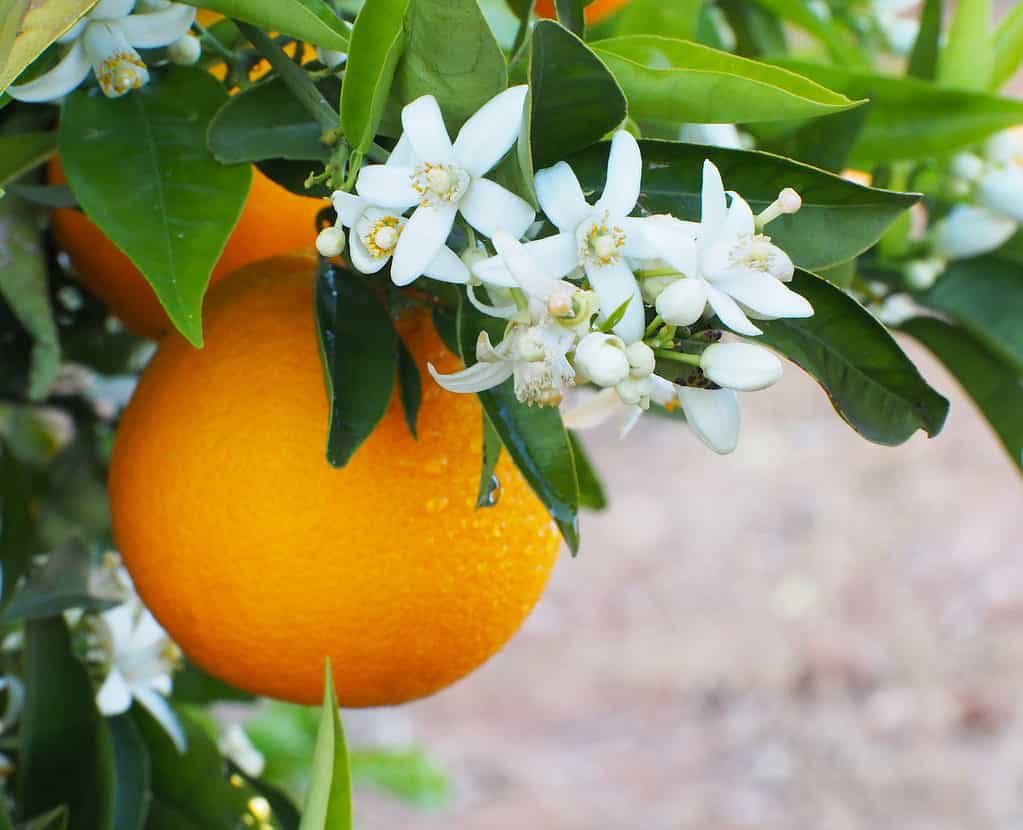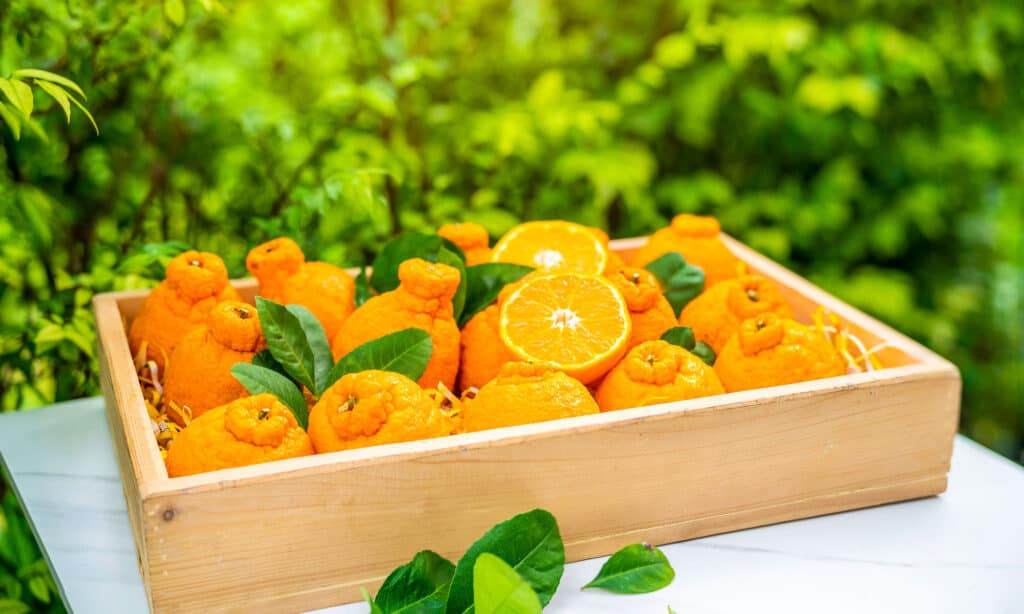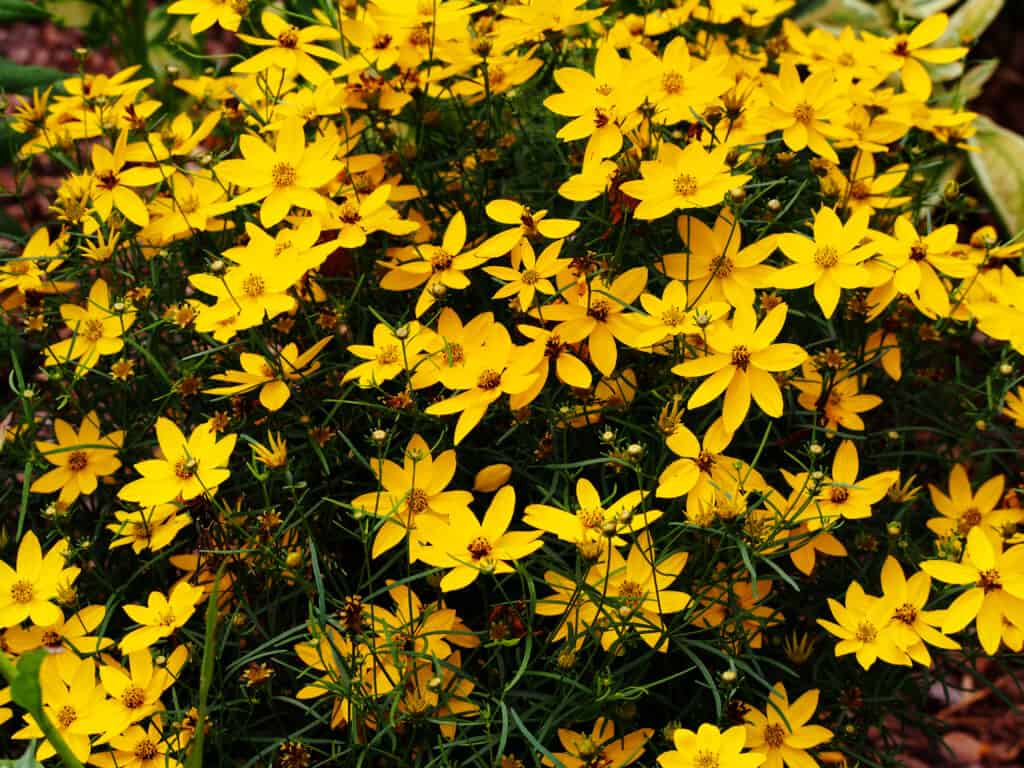When you think of Florida, some of the images that might come to mind are sunny beaches, palm trees, amusement parks, world-class fishing, and groves of orange trees. Florida produces some 11 million tons of oranges a year, or 70% of the total U.S. production. It’s not surprising then that the official state flower would be the orange blossom. Florida also has an official wildflower, which we’ll talk about in a bit. Get ready to discover the official state flower of Florida, including when it blooms and where to see it . . . plus find out whether it’s something you might be able to raise in your own home or garden.

The sweet smell of orange blossoms fills the air of Central and South Florida.
©Iness_la_luz/Shutterstock.com
History of the Orange
Orange trees were first developed as hybrids of pomelos and mandarins in Southeast Asia, in Myanmar and neighboring regions of China and India. They were first mentioned in Chinese literature in 314 BC. From there they spread through trade to the Near East and North Africa. In the 9th century oranges were introduced to Sicily, and in the 10th century, the Moors began cultivating oranges in Spain. For hundreds of years, they were considered a luxury for the rich. King Louis XIV grew large numbers of them in pots in the palace of Versailles.
Oranges were an important part of the era of European exploration. They were taken on sea voyages because they do not spoil easily, are rich in vitamin C, and helped prevent scurvy. Colonists took not only the fruit with them but fruit trees to plant all along their journey to benefit future sailors. Christopher Columbus may have been the first to introduce the orange to the New World, but later colonizers from Spain began cultivating them more systematically. They first came to Florida in 1565 with the founding of St. Augustine.
Today, oranges have become the most cultivated fruit tree in the world. Globally, 79 million tons of oranges are produced annually, with Brazil being the world’s largest producer, followed by China and India. In the United States, California, Texas, and Arizona are substantial orange producers, but Florida has by far the largest orange crop in the United States, producing 11 million tons a year, or 70% of the nation’s total.

Oranges are the most widely-cultivated fruit in the world.
©MERCURY studio/Shutterstock.com
Florida’s State Flower(s)
State Flower: The Orange Blossom
The Florida state legislature proclaimed the orange blossom the official state flower in 1909. In Florida, from February through March oranges bloom in several waves. The blossoms have soft, waxy, oval white star-shaped petals around a cluster of yellowish-orange stamens and they produce a strong sweet fragrance. You can see oranges in bloom all over southern and central Florida.
State Wildflower: Coreopsis
Since 1991, Florida also has had an official wildflower: coreopsis, or as it is commonly known: tickseed. It occurs naturally in pine forests, prairies, swamps, and along roadsides and has been used extensively in Florida for highway beautification programs around the state. Tickseed blooms in late summer through early winter with bright yellow or yellow and red flowers similar to daisies.

Coreopsis blooms with yellow or yellow and red daisy-like flowers.
©iStock.com/Gratysanna
Cultivating Florida’s State Flowers at Home
Cultivating Orange Trees
If you’d like to raise an orange tree yourself you can plant one outdoors in USDA hardiness zones 9-11. They do best in a warm subtropical climate with moderate humidity. When the temperature drops below 50 degrees Fahrenheit orange trees go dormant. If you live in a colder climate, you can still cultivate an orange tree indoors. Here are a few pointers for doing that successfully:
- Place them by a sunny window facing east, west, or south, or use a grow light. They should get 8-12 hours of light a day, but not overnight.
- Keep the temperature between 55 and 80°F
- They need slightly acidic (pH 6 to 7) loam-based soil. You can buy potting mix specifically for citrus trees.
- Water regularly, but make sure the soil is well-drained and kept slightly dry to prevent fungal growth.
- Provide humidity by putting the plant near a humidifier or misting the leaves, especially in winter.
- Use a high-nitrogen fertilizer every three weeks in spring and summer, and every six weeks in fall and winter.
- Look out for curled, spotted, or yellowed leaves, sticky deposits, or silky webs that could be signs of infestations of aphids, scale, spider mites, or mealybugs.
Cultivating Coreopsis
Tickseed grows well in USDA Hardiness Zones 4-10. In warmer climates, they can be a perennial but grow in cooler areas as a summer annual. Here are some pointers for raising coreopsis successfully in your garden:
- Coreopsis does best in full sun.
- It grows in a variety of soils with an ideal pH of 5.5-6.5. It does not do as well in rich soils.
- New plants should be kept moist but not soggy.
- Once they are established, they are very drought-tolerant. Allow the soil to dry, then water them to moisten it down to a depth of an inch or so.
- Coreopsis is a hardy plant. Look for it to bloom enthusiastically!

Some species of orange trees are suitable for Bonsai cultivation.
©lucas nightingale/Shutterstock.com
The photo featured at the top of this post is © PradaBrown/Shutterstock.com
Thank you for reading! Have some feedback for us? Contact the AZ Animals editorial team.






